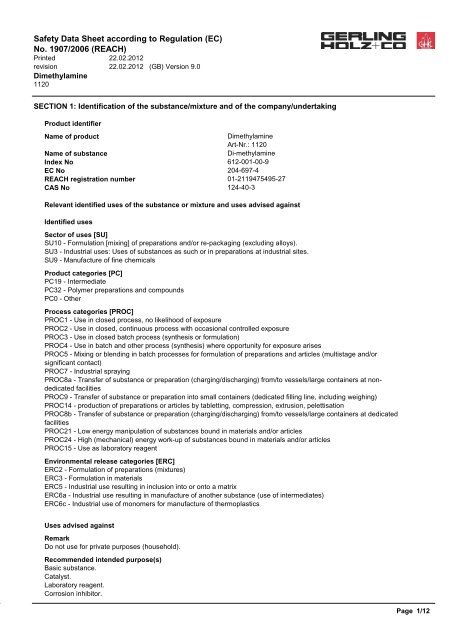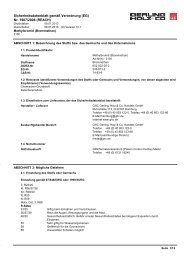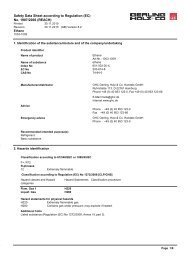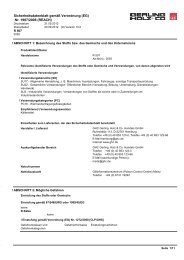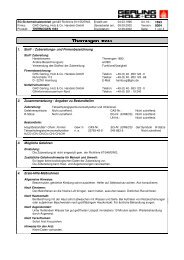material safety data sheet - GHC Gerling, Holz + Co. Handels GmbH
material safety data sheet - GHC Gerling, Holz + Co. Handels GmbH
material safety data sheet - GHC Gerling, Holz + Co. Handels GmbH
Create successful ePaper yourself
Turn your PDF publications into a flip-book with our unique Google optimized e-Paper software.
Safety Data Sheet according to Regulation (EC)<br />
No. 1907/2006 (REACH)<br />
Printed 22.02.2012<br />
revision 22.02.2012 (GB) Version 9.0<br />
Dimethylamine<br />
1120<br />
SECTION 1: Identification of the substance/mixture and of the company/undertaking<br />
Product identifier<br />
Name of product Dimethylamine<br />
Art-Nr.: 1120<br />
Name of substance Di-methylamine<br />
Index No 612-001-00-9<br />
EC No 204-697-4<br />
REACH registration number 01-2119475495-27<br />
CAS No 124-40-3<br />
Relevant identified uses of the substance or mixture and uses advised against<br />
Identified uses<br />
Sector of uses [SU]<br />
SU10 - Formulation [mixing] of preparations and/or re-packaging (excluding alloys).<br />
SU3 - Industrial uses: Uses of substances as such or in preparations at industrial sites.<br />
SU9 - Manufacture of fine chemicals<br />
Product categories [PC]<br />
PC19 - Intermediate<br />
PC32 - Polymer preparations and compounds<br />
PC0 - Other<br />
Process categories [PROC]<br />
PROC1 - Use in closed process, no likelihood of exposure<br />
PROC2 - Use in closed, continuous process with occasional controlled exposure<br />
PROC3 - Use in closed batch process (synthesis or formulation)<br />
PROC4 - Use in batch and other process (synthesis) where opportunity for exposure arises<br />
PROC5 - Mixing or blending in batch processes for formulation of preparations and articles (multistage and/or<br />
significant contact)<br />
PROC7 - Industrial spraying<br />
PROC8a - Transfer of substance or preparation (charging/discharging) from/to vessels/large containers at nondedicated<br />
facilities<br />
PROC9 - Transfer of substance or preparation into small containers (dedicated filling line, including weighing)<br />
PROC14 - production of preparations or articles by tabletting, compression, extrusion, pelettisation<br />
PROC8b - Transfer of substance or preparation (charging/discharging) from/to vessels/large containers at dedicated<br />
facilities<br />
PROC21 - Low energy manipulation of substances bound in <strong>material</strong>s and/or articles<br />
PROC24 - High (mechanical) energy work-up of substances bound in <strong>material</strong>s and/or articles<br />
PROC15 - Use as laboratory reagent<br />
Environmental release categories [ERC]<br />
ERC2 - Formulation of preparations (mixtures)<br />
ERC3 - Formulation in <strong>material</strong>s<br />
ERC5 - Industrial use resulting in inclusion into or onto a matrix<br />
ERC6a - Industrial use resulting in manufacture of another substance (use of intermediates)<br />
ERC6c - Industrial use of monomers for manufacture of thermoplastics<br />
Uses advised against<br />
Remark<br />
Do not use for private purposes (household).<br />
Recommended intended purpose(s)<br />
Basic substance.<br />
Catalyst.<br />
Laboratory reagent.<br />
<strong>Co</strong>rrosion inhibitor.<br />
Page 1/12
Safety Data Sheet according to Regulation (EC)<br />
No. 1907/2006 (REACH)<br />
Printed 22.02.2012<br />
revision 22.02.2012 (GB) Version 9.0<br />
Dimethylamine<br />
1120<br />
Details of the supplier of the <strong>safety</strong> <strong>data</strong> <strong>sheet</strong><br />
Manufacturer/distributor <strong>GHC</strong> <strong>Gerling</strong>, <strong>Holz</strong> & <strong>Co</strong>. <strong>Handels</strong> <strong>GmbH</strong><br />
Ruhrstraße 113, D-22761 Hamburg<br />
Phone +49 (0) 40 853 123-0, Fax +49 (0) 40 853 123-66<br />
E-Mail hamburg@ghc.de<br />
Internet www.ghc.de<br />
Advice<br />
Emergency telephone number<br />
Phone +49 (0) 40 853 123-0<br />
Fax +49 (0) 40 853 123-66<br />
E-mail (competent person):<br />
msds@ghc.de<br />
Emergency advice Giftinformationszentrum Mainz<br />
Phone +49 (0) 6131 19240<br />
! SECTION 2: Hazards identification<br />
Classification of the substance or mixture<br />
Classification according to 67/548/EEC or 1999/45/EC<br />
F+; R12<br />
Xn; R20<br />
Xi; R37/38<br />
Xi; R41<br />
R-phrases<br />
12 Extremely flammable.<br />
20 Harmful by inhalation.<br />
37/38 Irritating to respiratory system and skin.<br />
41 Risk of serious damage to eyes.<br />
Additional hints<br />
Listed substance (Regulation (EC) No 1272/2008, Annex VI, part 3).<br />
! Classification according to Regulation (EC) No 1272/2008 [CLP/GHS]<br />
Hazard classes and Hazard<br />
categories<br />
Flam. Gas 1 H220<br />
Liquef. Gas H280<br />
Acute Tox. 4 H332<br />
Skin Irrit. 2 H315<br />
Eye Dam. 1 H318<br />
STOT SE 3 H335<br />
Aquatic Chronic 3 H412<br />
Hazard Statements Classification procedure<br />
Hazard statements for physical hazards<br />
H220 Extremely flammable gas.<br />
H280 <strong>Co</strong>ntains gas under pressure; may explode if heated.<br />
Hazard statements for health hazards<br />
H315 Causes skin irritation.<br />
H318 Causes serious eye damage.<br />
H332 Harmful if inhaled.<br />
Page 2/12
Safety Data Sheet according to Regulation (EC)<br />
No. 1907/2006 (REACH)<br />
Printed 22.02.2012<br />
revision 22.02.2012 (GB) Version 9.0<br />
Dimethylamine<br />
1120<br />
H335 May cause respiratory irritation.<br />
! Hazard statements for environmental hazards<br />
H412 Harmful to aquatic life with long lasting effects.<br />
Additional hints<br />
Listed substance (Regulation (EC) No 1272/2008, Annex VI, part 3).<br />
Label elements<br />
Labelling according to Regulation (EC) No 1272/2008 [CLP/GHS]<br />
GHS02 GHS04 GHS05 GHS07<br />
! Signal word<br />
Danger<br />
Hazard statements for physical hazards<br />
H220 Extremely flammable gas.<br />
H280 <strong>Co</strong>ntains gas under pressure; may explode if heated.<br />
Hazard statements for health hazards<br />
H315 Causes skin irritation.<br />
H318 Causes serious eye damage.<br />
H332 Harmful if inhaled.<br />
H335 May cause respiratory irritation.<br />
! Hazard statements for environmental hazards<br />
H412 Harmful to aquatic life with long lasting effects.<br />
Precautionary Statements<br />
! Prevention<br />
P210 Keep away from heat/sparks/open flames/hot surfaces. – No smoking.<br />
P260 Do not breathe gas/vapours.<br />
P273 Avoid release to the environment.<br />
P280 Wear protective gloves/protective clothing/eye protection/face protection.<br />
Response<br />
P304 + P340 IF INHALED: Remove to fresh air and keep at rest in a position comfortable for breathing.<br />
P305 + P351 + IF IN EYES: Rinse cautiously with water for several minuts. Remove contact lenses, if present<br />
P338<br />
and easy to do. <strong>Co</strong>ntinue rinsing.<br />
P315 Get immediate medical advice/attention.<br />
Storage<br />
P403 Store in a well-ventilated place.<br />
! Hazardous ingredients for labeling<br />
Di-methylamine<br />
Other hazards<br />
! Information pertaining to special dangers for human and environment<br />
Dangerous substances are released in case of decomposition.<br />
Gas/vapour heavier than air. May accumulate in confined spaces, particularly at or below ground level.<br />
<strong>Co</strong>ntact with liquid may cause cold burns/frostbite.<br />
Page 3/12
Safety Data Sheet according to Regulation (EC)<br />
No. 1907/2006 (REACH)<br />
Printed 22.02.2012<br />
revision 22.02.2012 (GB) Version 9.0<br />
Dimethylamine<br />
1120<br />
! SECTION 3: <strong>Co</strong>mposition/ information on ingredients<br />
Substances<br />
CAS No 124-40-3 Di-methylamine<br />
EC No 204-697-4<br />
Index No 612-001-00-9<br />
REACH registration number 01-2119475495-27<br />
! SECTION 4: First aid measures<br />
Description of first aid measures<br />
General information<br />
Remove contaminated soaked clothing immediately.<br />
Adhere to personal protective measures when giving first aid.<br />
Seek medical treatment immediately.<br />
! In case of inhalation<br />
Remove the casualty into fresh air and keep him immobile.<br />
In the event of pulmonary irritation treat initially with corticoid spray, e.g. Ventolair- or Pulmicort- metered-dose aerosol<br />
(Ventolair and Pulmicort are registrated trademarks).<br />
Seek medical treatment immediately.<br />
In case of respiratory standstill give artifical respiration by respiratory bag (Ambu bag) or respirator. Send for a doctor.<br />
In case of skin contact<br />
In case of contact with skin wash off with warm water.<br />
In case of frostbite rinse with plenty of water. Don`t remove clothing.<br />
In case of frostbite spray with lukewarm (not hot) water for at least 15 minutes. Apply a sterile dressing. Obtain<br />
medical assistance.<br />
! In case of eye contact<br />
Rinse cautiously with water for several minuts. Remove contact lenses, if present and easy to do. <strong>Co</strong>ntinue rinsing.<br />
Call for a doctor immediately.<br />
In case of ingestion<br />
Ingestion is not considered a potential route of exposure.<br />
Most important symptoms and effects, both acute and delayed<br />
! Physician's information / possible symptoms<br />
<strong>Co</strong>ughing<br />
Shortness of breath<br />
Physician's information / possible dangers<br />
Risk of pulmonary irritation<br />
Risk of pulmonary oedema<br />
Indication of any immediate medical attention and special treatment needed<br />
! Treatment (Advice to doctor)<br />
If necessary, give oxygen.<br />
<strong>Co</strong>ntinue to monitor for pneumonia and pulmonary oedema.<br />
Pulmonary oedema prophylaxis.<br />
Page 4/12
Safety Data Sheet according to Regulation (EC)<br />
No. 1907/2006 (REACH)<br />
Printed 22.02.2012<br />
revision 22.02.2012 (GB) Version 9.0<br />
Dimethylamine<br />
1120<br />
! SECTION 5: Firefighting measures<br />
Extinguishing media<br />
! Suitable extinguishing media<br />
Foam<br />
Dry powder<br />
Carbon dioxide<br />
Water spray jet<br />
Extinguishing media which must not be used for <strong>safety</strong> reasons<br />
Full water jet<br />
Special hazards arising from the substance or mixture<br />
In case of fire formation of dangerous gases possible.<br />
Formation of explosive gas mixtures in air.<br />
In the event of fire the following can be released:<br />
Nitrogen oxides (NOx)<br />
Carbon monoxide (CO)<br />
Carbon dioxide (CO2)<br />
Advice for firefighters<br />
Special protective equipment for fire-fighters<br />
Use breathing apparatus with independent air supply ( isolated ).<br />
Wear full protective clothing.<br />
! Additional information<br />
<strong>Co</strong>ol endangered containers with water spray jet.<br />
Exposure to fire may cause containers to rupture / explode.<br />
Do not extinguish a leaking gas flame unless absolutely necessary. Spontaneous/explosive re-ignition may occur.<br />
Extinguish any other fire.<br />
! SECTION 6: Accidental release measures<br />
Personal precautions, protective equipment and emergency procedures<br />
See chapter 8.<br />
Remove persons to <strong>safety</strong>.<br />
Keep people away and stay on the upwind side.<br />
Keep away sources of ignition.<br />
Environmental precautions<br />
<strong>Co</strong>llect contaminated water / firefighting water separately.<br />
If possible, stop flow of product.<br />
Eliminate ignition sources.<br />
Do not discharge into the drains/surface waters/groundwater.<br />
If necessary, secure leaky pressure receptacles in a salvage packaging.<br />
Suppress gases/vapours/mists with water spray jet<br />
Do not discharge into the subsoil/soil.<br />
Methods and <strong>material</strong> for containment and cleaning up<br />
Ensure adequate air ventilation.<br />
Flush away residues with water.<br />
Reference to other sections<br />
Informations for safe handling see chapter 7.<br />
Informations for personal protective equipment see chapter 8.<br />
Page 5/12
Safety Data Sheet according to Regulation (EC)<br />
No. 1907/2006 (REACH)<br />
Printed 22.02.2012<br />
revision 22.02.2012 (GB) Version 9.0<br />
Dimethylamine<br />
1120<br />
! SECTION 7: Handling and storage<br />
Precautions for safe handling<br />
! Advice on safe handling<br />
Use only in thoroughly ventilated areas.<br />
Transfer and handle only in enclosed systems.<br />
Barrels and installations thoroughly earthing (grounding ).<br />
Use antistatic tools.<br />
Treatment only in suitable rooms and systems.<br />
Provide good room ventilation even at ground level (vapours are heavier than air).<br />
Prevent cylinders from falling over.<br />
Ensure valve protection device is correctly fitted.<br />
Ensure valve outlet cap nut or plug (where provided) is correctly fitted.<br />
Open valve slowly to avoid pressure shock.<br />
Do not allow backfeed into the container.<br />
Suck back of water into the container must be prevented.<br />
No water to valves, flanges and other fittings.<br />
Purging of pipes and valves with inert gases - to avoid: water, solvents.<br />
Advice on protection against fire and explosion<br />
The product is combustible.<br />
Because of risk of explosion avoid vapours getting into cellar, sewage system and holes.<br />
Take precautionary measures against static discharges.<br />
Formation of explosive gas mixtures in air.<br />
Use explosion-proof equipment / fittings and non-sparking tools.<br />
<strong>Co</strong>nditions for safe storage, including any incompatibilities<br />
Requirements for storage rooms and vessels<br />
Keep in closed original container.<br />
Ventilate store-rooms thoroughly.<br />
Use transportable pressure equipment.<br />
Suitable <strong>material</strong>s: Normalised steel and carbon steel, tempered steel, aluminium alloys.<br />
Valve: Suitable <strong>material</strong>s: Carbon steels, aluminium alloys, stainless steel.<br />
Unsuitable <strong>material</strong>s: Brass, copper alloys.<br />
! Advice on storage compatibility<br />
Do not store with spontaneously flammable <strong>material</strong>s.<br />
Do not store together with combustible liquids or combustible solids.<br />
Do not store together with animal feedstuffs.<br />
Do not store together with explosives.<br />
Do not store together with infectious substances.<br />
Do not store together with radioactive <strong>material</strong>.<br />
Do not store together with toxic liquids or toxic solids.<br />
Do not store together with food.<br />
Do not store together with acids.<br />
Do not store together with oxidizing liquids or oxidizing solids.<br />
! Further information on storage conditions<br />
Ensure valve protection device is correctly fitted.<br />
Keep container tightly closed and store at cool and aired place.<br />
Prevent cylinders from falling over.<br />
Protect of heat.<br />
Storage temperature may not exceed 50°C (=122°F).<br />
! Information on storage stability<br />
Storage time: 24 months.<br />
Page 6/12
Safety Data Sheet according to Regulation (EC)<br />
No. 1907/2006 (REACH)<br />
Printed 22.02.2012<br />
revision 22.02.2012 (GB) Version 9.0<br />
Dimethylamine<br />
1120<br />
Specific end use(s)<br />
! Recommendation(s) for intended use<br />
See exposure scenario(s).<br />
! SECTION 8: Exposure controls/personal protection<br />
<strong>Co</strong>ntrol parameters<br />
Ingredients with occupational exposure limits to be monitored<br />
CAS No Name <strong>Co</strong>de [mg/m3] [ppm] Remark<br />
124-40-3 Dimethylamine WEL, 8 hours 3,8 2<br />
EH40, UK, 2007<br />
Short-term 11 6<br />
124-40-3 Dimethylamine PEL, 8 hours 18 10 OSHA, Table<br />
Z-1, USA<br />
Indicative occupational exposure limit values (91/322/EEC, 2000/39/EC, 2006/15/EC or 2009/161/EU)<br />
CAS No Name <strong>Co</strong>de [mg/m3] [ppm] Remark<br />
124-40-3 Di-methylamine 8 hours 3,8 2<br />
Short-term 9,4 5<br />
! Additional advice<br />
DNEL (workers, inhalation, long-term, systemic effects): 1,044 mg/m³ (0,6 ppm).<br />
DNEL (workers, dermal, long-term, systemic effects): 0,148 mg/kg.<br />
Exposure controls<br />
! Respiratory protection<br />
Wear self-contained breathing apparatus when entering area unless atmosphere is proved to be safe.<br />
Keep self contained breathing apparatus readily available for emergency use.<br />
Short term: filter apparatus, combination filter ABEK-P3.<br />
! Hand protection<br />
chemical-resistant gloves<br />
Glove <strong>material</strong> specification [make/type, thickness, permeation time/life]: NBR; 0,4 mm; >= 480 min<br />
Glove <strong>material</strong> specification [make/type, thickness, permeation time/life]: IIR, >= 0,7 mm, > 480 min<br />
Glove <strong>material</strong> specification [make/type, thickness, permeation time/life]: FKM, >= 0,7 mm, > 480 min<br />
Glove <strong>material</strong> specification [make/type, thickness, permeation time/life]: PVC, >= 0,7 mm, >= 480 min.<br />
! Eye protection<br />
<strong>safety</strong> goggles, in case of increased risk add protective face shield<br />
! Skin protection<br />
Safety shoes with steel toe.<br />
Body covering work clothing, or chemical resistant suit at increased risk.<br />
! General protective measures<br />
Do not inhale gases.<br />
! Hygiene measures<br />
At work do not eat, drink and smoke.<br />
! Limitation and surveillance of the environment<br />
PNEC (freshwater): 0,006 mg/l<br />
PNEC (sea water): 0.0006 mg/l / 0.006 mg/l (sporadic emission)<br />
PNEC (freshwater sediment): 0,0053 mg/kg<br />
PNEC (marine sediment): 0,00053 mg/kg<br />
PNEC (soil): 0,046 mg/kg<br />
PNEC (waste water treatment plant): 4,7 mg/l<br />
See chapter 7.<br />
Page 7/12
Safety Data Sheet according to Regulation (EC)<br />
No. 1907/2006 (REACH)<br />
Printed 22.02.2012<br />
revision 22.02.2012 (GB) Version 9.0<br />
Dimethylamine<br />
1120<br />
! SECTION 9: Physical and chemical properties<br />
Information on basic physical and chemical properties<br />
Form<br />
Gaseous / liquefied under pressure.<br />
<strong>Co</strong>lour<br />
colourless<br />
Important health, <strong>safety</strong> and environmental information<br />
Odour<br />
similar to amine<br />
Value Temperature at Method Remark<br />
pH value in delivery state 14 20 °C 350 g/l aqueous solution<br />
boiling point 7 °C 1013 hPa<br />
melting point -92,2 °C<br />
Flash point -55 °C DIN 51755<br />
Flammability (gas) Flammable.<br />
Ignition temperature 402 °C DIN 51794<br />
Autoignition no<br />
Lower explosion limit 2,8 Vol-%<br />
Upper explosion limit 14,4 Vol-%<br />
Vapour pressure 1688 hPa 20 °C<br />
Density 0,657 g/cm3 20 °C information<br />
concerns to<br />
liquid phase<br />
Rel. vapour density 1,557 air = 1<br />
Solubility in water 340 g/l 20 °C miscible<br />
Solubility/other soluble in<br />
organic solvent<br />
Partition coefficient (log<br />
pOW)<br />
-0,274 25 °C OECD 107<br />
Viscosity dynamic 0,196 mPa*s 20 °C liquid phase<br />
! Oxidizing properties<br />
no<br />
! Explosive properties<br />
Due to its structure the product is not classified as explosive.<br />
Other information<br />
Vapours are heavier than air.<br />
Page 8/12
Safety Data Sheet according to Regulation (EC)<br />
No. 1907/2006 (REACH)<br />
Printed 22.02.2012<br />
revision 22.02.2012 (GB) Version 9.0<br />
Dimethylamine<br />
1120<br />
! SECTION 10: Stability and reactivity<br />
Reactivity<br />
See section "Possibility of hazardous reactions".<br />
Chemical stability<br />
Stable under normal conditions.<br />
Possibility of hazardous reactions<br />
May react violently with oxidants.<br />
Strong exothermic reaction with acids.<br />
<strong>Co</strong>nditions to avoid<br />
Formation of explosive gas/air mixtures.<br />
Heat sources / heat - risk of bursting.<br />
Sources of ignition.<br />
Incompatible <strong>material</strong>s<br />
! Materials to avoid<br />
<strong>Co</strong>pper, brass and other copper alloys.<br />
Acids.<br />
Oxidants.<br />
Hazardous decomposition products<br />
Nitrous gases<br />
Carbon monoxide and carbon dioxide.<br />
Thermal decomposition<br />
Remark No decomposition if used as directed.<br />
! SECTION 11: Toxicological information<br />
Information on toxicological effects<br />
Acute toxicity/Irritability/Sensitization<br />
LC50 acute<br />
inhalation<br />
Value/Validation Species Method Remark<br />
> 5800 mg/m3 (4 h) rat<br />
Irritability skin irritant rabbit<br />
Irritability eye risk of strong eye<br />
injuries<br />
Skin sensitization not applicable<br />
Sensitization<br />
respiratory system<br />
not applicable<br />
Subacute Toxicity - Carcinogenicity<br />
rabbit eye<br />
Value Species Method Validation<br />
Page 9/12
Safety Data Sheet according to Regulation (EC)<br />
No. 1907/2006 (REACH)<br />
Printed 22.02.2012<br />
revision 22.02.2012 (GB) Version 9.0<br />
Dimethylamine<br />
1120<br />
Value Species Method Validation<br />
Subchronic Toxicity Also in case of a repeated<br />
intake the main effect is the<br />
local irritation.<br />
Mutagenicity No experimental information<br />
on genotoxicity in vivo available.<br />
Reproduction-<br />
Toxicity<br />
The product has not been tested. The<br />
information is derived from products of similar<br />
composition.<br />
No indications of toxic effects<br />
were observed in reproduction<br />
studies in animals.<br />
Carcinogenicity No indications of carcinogenic<br />
effects are available from longterm<br />
trials.<br />
! Experiences made from practice<br />
May cause frostbite.<br />
Irritates respiratory tract.<br />
! SECTION 12: Ecological information<br />
Toxicity<br />
Ecotoxicological effects<br />
Value Species Method Validation<br />
Fish LC50 118 mg/l (96 h) Oncorhynchus<br />
mykiss<br />
Daphnia EC50 48 mg/l (24 h) Daphnia magna<br />
Algae EC50 9 mg/l (96 h) Selenastrum<br />
capricornutum<br />
Bacteria EC10 > 1000 mg/l (30 h) activated sludge<br />
(kom.)<br />
NOEC (30 d): 20 mg/l (O.<br />
mykiss); NOEC (50 d): 0,6<br />
mg/l (O. mykiss)<br />
! Behaviour in sewage plant<br />
When low concentrations are discharged correctly into adapted biological sewage treatment plants, interference with<br />
the degradation activity of activated sludge is not likely.<br />
Due to the pH-value normally a neutralization is necessary before waste water is discharged into sewage treatment<br />
plants.<br />
Persistence and degradability<br />
Biological<br />
degradability<br />
The product is readily biodegradable to OECD criteria.<br />
Degradability 88 % (28 d) BOD in % of<br />
theoretical OD<br />
OECD 301 C<br />
Page 10/12
Safety Data Sheet according to Regulation (EC)<br />
No. 1907/2006 (REACH)<br />
Printed 22.02.2012<br />
revision 22.02.2012 (GB) Version 9.0<br />
Dimethylamine<br />
1120<br />
Biological<br />
eliminability<br />
Elimination rate Method of analysis Method Validation<br />
At normal temperature very highly volatile or gaseous product that can be released to atmosphere.<br />
Elimination test cannot be employed.<br />
Bioaccumulative potential<br />
Because of the n-octanol/water distribution coefficient (log K o/w) accumulation in organisms is not expected.<br />
Mobility in soil<br />
high mobility<br />
Results of PBT and vPvB assessment<br />
This substance does not meet the PBT/vPvB criteria of REACH, annex XIII.<br />
Other adverse effects<br />
Not known.<br />
! General regulation<br />
Do not allow uncontrolled leakage of product into the environment.<br />
! SECTION 13: Disposal considerations<br />
Waste treatment methods<br />
Waste code No. Name of waste<br />
16 05 04* gases in pressure containers (including halons) containing dangerous substances<br />
Wastes marked with an asterisk are considered to be hazardous waste pursuant to Directive 91/689/EEC on hazardous<br />
waste.<br />
! Recommendations for the product<br />
Dispose of as hazardous waste.<br />
Recommendations for packaging<br />
Transportable pressure equipment (empty, residual pressure): Return to supplier / manufacturer.<br />
! SECTION 14: Transport information<br />
! Land and inland navigation transport ADR/RID<br />
UN 1032 DIMETHYLAMINE, ANHYDROUS, 2.1, (B/D), Classification code: 2F<br />
! Marine transport IMDG<br />
UN 1032 DIMETHYLAMINE, ANHYDROUS, 2.1<br />
Ems: F-D, S-U<br />
! Air transport ICAO/IATA-DGR<br />
UN 1032 Dimethylamine, anhydrous, 2.1<br />
Cargo aircraft only.<br />
Special precautions for user<br />
The protective measures listed in Sections 6, 7 and 8 of the Safety Data Sheet have to be considered.<br />
Transport in bulk according to Annex II of MARPOL 73/78 and the IBC <strong>Co</strong>de<br />
No transport as bulk according IBC - <strong>Co</strong>de.<br />
Page 11/12
Safety Data Sheet according to Regulation (EC)<br />
No. 1907/2006 (REACH)<br />
Printed 22.02.2012<br />
revision 22.02.2012 (GB) Version 9.0<br />
Dimethylamine<br />
1120<br />
! SECTION 15: Regulatory information<br />
Safety, health and environmental regulations/legislation specific for the substance or mixture<br />
! Other regulations (EU)<br />
Regulation (EC) No 1907/2006 concerning the Registration, Evaluation, Authorisation and Restriction of Chemicals<br />
(REACH), Annex XVII No 40.<br />
Directive 96/82/EC on the control of major-accident hazards involving dangerous substances.<br />
VOC standard<br />
VOC content >=99,5 % 20 °C 1620 hPa<br />
Chemical Safety Assessment<br />
For this substance a chemical <strong>safety</strong> assessment has been carried out.<br />
Exposure scenarios (ESs) see http://www.ghc.de/pdf_e/es1120.001e.pdf.<br />
SECTION 16: Other information<br />
Recommended uses and restrictions<br />
National and local regulations concerning chemicals shall be observed.<br />
Further information<br />
All declarations of <strong>safety</strong>-<strong>data</strong>-<strong>sheet</strong> refer to pure substance.<br />
The information contained herein is based on the state of our knowledge. It characterizes the product with regard to<br />
the appropriate <strong>safety</strong> precautions. It does not represent a guarantee of the properties of the product.<br />
Wording of the R/H-phrases specified in chapter 3 (not the classification of the mixture!)<br />
R 12 Extremely flammable.<br />
R 20 Harmful by inhalation.<br />
R 37/38 Irritating to respiratory system and skin.<br />
R 41 Risk of serious damage to eyes.<br />
H220 Extremely flammable gas.<br />
H280 <strong>Co</strong>ntains gas under pressure; may explode if heated.<br />
H315 Causes skin irritation.<br />
H318 Causes serious eye damage.<br />
H331 Toxic if inhaled.<br />
H335 May cause respiratory irritation.<br />
H412 Harmful to aquatic life with long lasting effects.<br />
Page 12/12


